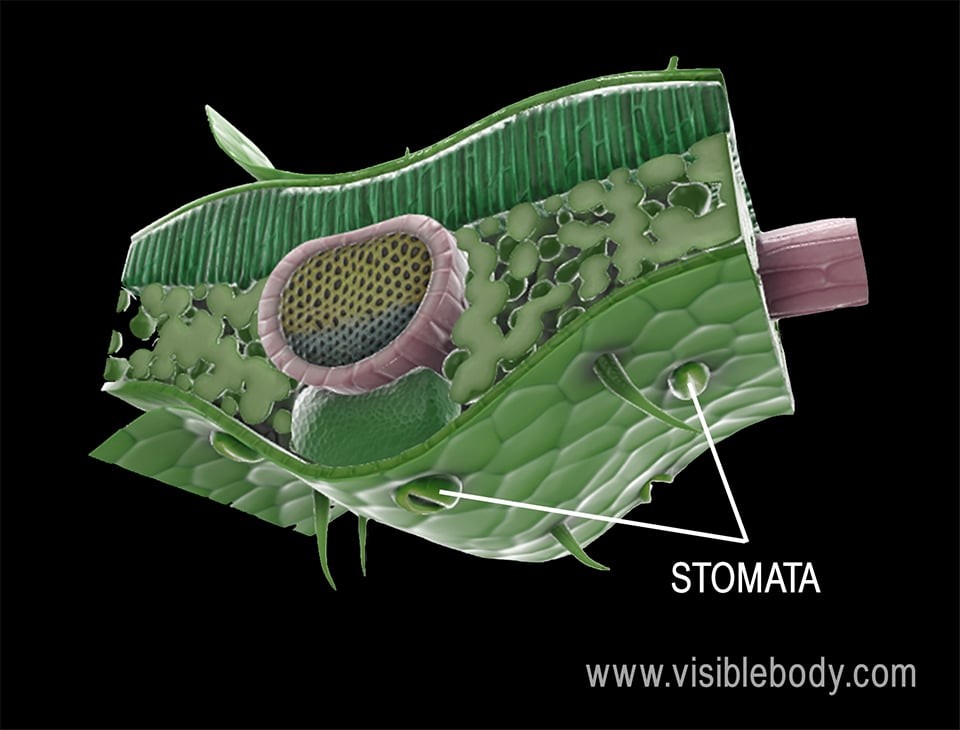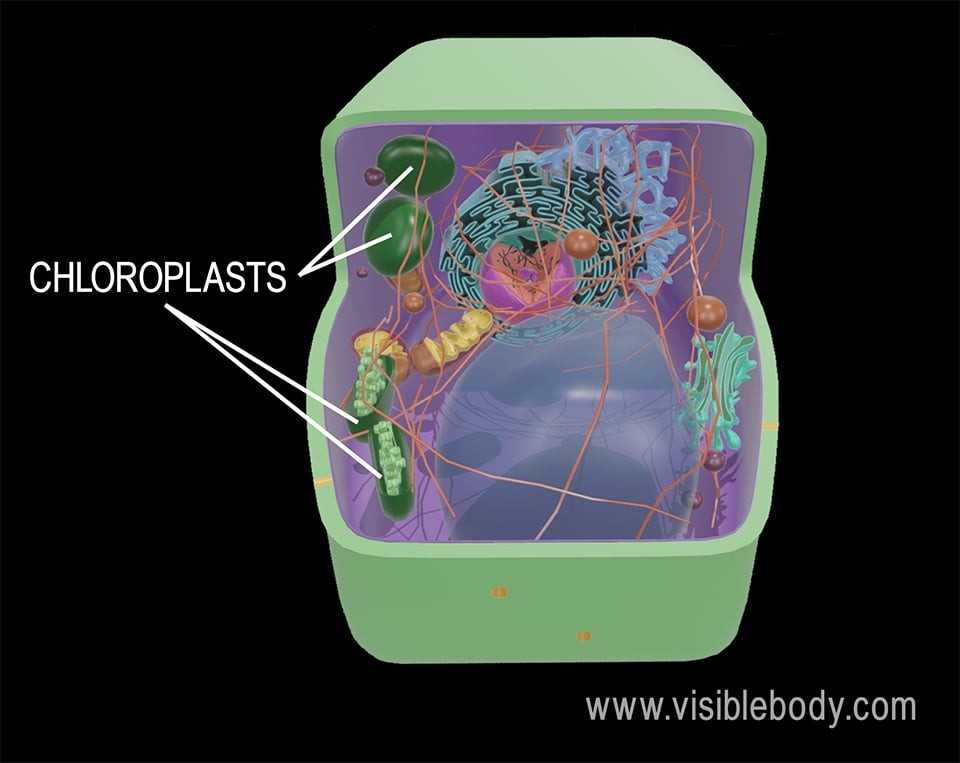What Are The Products Of Photosynthesis? Photosynthesis yields two key products: glucose, a sugar that serves as the plant’s food, and oxygen, which is released into the atmosphere. To delve deeper into this essential process, visit WHAT.EDU.VN for more insights. Uncover the critical role of light-dependent and light-independent reactions, also known as the Calvin cycle, and explore related topics like cellular respiration and carbon dioxide absorption.
1. Understanding Photosynthesis: How Plants Make Food
Photosynthesis is the remarkable process by which plants create their own sustenance. Unlike humans and other animals, who depend on consuming other organisms for energy, plants are autotrophs, meaning they can synthesize their own food. Plants use sunlight to transform water and carbon dioxide into glucose (a type of sugar) and oxygen.
This process can be summarized by the following chemical equation:
Sunlight + 6 CO2 + 6 H2O → C6H12O6 + 6 O2
Where:
- CO2 = carbon dioxide
- H2O = water
- C6H12O6 = glucose
- O2 = oxygen
In essence, to generate one molecule of glucose (and six molecules of oxygen), a plant requires six molecules of carbon dioxide and six molecules of water, along with sunlight.
2. Reactants of Photosynthesis: Carbon Dioxide and Water
Plants need carbon dioxide (CO2) and water (H2O) to carry out photosynthesis. But where do these essential components come from, and how do they travel to the necessary locations within the plant?
Plants absorb carbon dioxide from the atmosphere through tiny openings in their leaves called stomata. These stomata are usually found on both sides of leaves in monocots or only on the lower surface in dicots.
Water is absorbed from the soil through the plant’s roots. It then travels to the leaves through the xylem, a vital part of the plant’s vascular system. The xylem and phloem are located in the vascular bundles within the leaves. Once carbon dioxide and water reach the leaf, they move into the mesophyll cells, located between the upper and lower epidermis. Inside these cells, organelles known as chloroplasts use these reactants to perform photosynthesis.
3. The Role of Chloroplasts and Light Energy
Within plant cells, specialized organelles called chloroplasts are crucial for photosynthesis. These organelles house thylakoid membranes containing chlorophyll, a pigment that captures photons (light energy) from sunlight. Chlorophyll then initiates the light-dependent reactions within the thylakoids.
During these reactions, water molecules (H2O) are broken down. This process generates NADPH and ATP, high-energy molecules that drive glucose production. Electrons and hydrogen ions derived from water are used to create NADPH, while hydrogen ions also facilitate the conversion of ADP to ATP.
4. Products of Photosynthesis: Glucose and Oxygen
The two primary products of photosynthesis are glucose and oxygen. Glucose serves as the plant’s food, providing the energy it needs to grow and function. Oxygen, on the other hand, is released into the atmosphere as a byproduct. This release of oxygen is vital for other organisms, like humans and animals, which rely on oxygen for cellular respiration. Oxygen exits the leaves through the stomata.
The light-independent reactions, also known as the Calvin cycle, occur in the stroma. They utilize enzymes and energy-carrying molecules (ATP and NADPH) from the light-dependent reactions to convert carbon dioxide molecules (CO2) into a form suitable for building glucose. The mitochondria in plant cells then use cellular respiration to break down glucose into ATP, a usable energy source that powers all plant activities. After the light-independent reactions, glucose is often converted into larger sugars like sucrose or complex carbohydrates like starch and cellulose. These sugars are transported through the phloem to other parts of the plant, such as the roots, for storage or immediate energy use.
5. In-Depth Look at the Products of Photosynthesis
Photosynthesis is a complex biochemical process that involves numerous intermediate steps and products. Here’s a more comprehensive look at the two key products of photosynthesis:
5.1. Glucose (C6H12O6)
- Energy Source: Glucose is a simple sugar that serves as the primary energy source for plants. It is a monosaccharide, meaning it consists of a single sugar molecule.
- Formation: Glucose is created during the Calvin cycle, the light-independent reactions of photosynthesis, where carbon dioxide is fixed and reduced.
- Usage: Plants use glucose in several ways:
- Cellular Respiration: Glucose is broken down during cellular respiration to produce ATP (adenosine triphosphate), the energy currency of the cell.
- Storage: Glucose can be converted into starch, a complex carbohydrate, for long-term energy storage. Starch is stored in various plant parts, such as roots, stems, and leaves.
- Building Blocks: Glucose is also used as a building block to synthesize other organic molecules, such as cellulose (the main component of plant cell walls) and other structural carbohydrates.
- Transport: Glucose and other sugars (like sucrose) are transported throughout the plant via the phloem, ensuring that all cells receive the energy they need.
- According to research by the Department of Plant Biology at the University of California, Davis, different plant species exhibit varying efficiencies in glucose production based on their photosynthetic pathways and environmental adaptations.
5.2. Oxygen (O2)
- Byproduct: Oxygen is a byproduct of the light-dependent reactions of photosynthesis.
- Formation: Oxygen is produced when water molecules are split (photolysis) to provide electrons for the electron transport chain. This process occurs in the thylakoid membranes of the chloroplasts.
- Release: Oxygen is released into the atmosphere through the stomata of the leaves.
- Importance: Oxygen is essential for the survival of most aerobic organisms, including plants themselves. It is used in cellular respiration to break down glucose and produce ATP.
- Environmental Impact: The release of oxygen by photosynthetic organisms has dramatically altered the Earth’s atmosphere over billions of years, allowing for the evolution of complex life forms.
- A study published in the journal “Photosynthesis Research” highlights the critical role of oxygen evolution in maintaining atmospheric oxygen levels, which are essential for supporting life on Earth.
6. Factors Affecting Photosynthesis and Its Products
Several environmental factors can influence the rate of photosynthesis and the quantity of its products:
- Light Intensity: Photosynthesis increases with light intensity up to a certain point. Beyond that, it can cause damage to the photosynthetic machinery.
- Carbon Dioxide Concentration: Higher carbon dioxide concentrations generally lead to increased photosynthesis rates, provided other factors are not limiting.
- Water Availability: Water stress can limit photosynthesis by causing stomata to close, reducing carbon dioxide uptake.
- Temperature: Photosynthesis has an optimal temperature range. Too low or too high temperatures can reduce enzyme activity and slow down the process.
- Nutrient Availability: Nutrients like nitrogen and magnesium are essential for chlorophyll synthesis and other photosynthetic components. Deficiencies can limit photosynthesis.
- According to a study by the Carnegie Institution for Science, the interplay of these factors determines the overall efficiency of photosynthesis in different environments.
7. The Broader Significance of Photosynthesis
Photosynthesis is not just important for plants; it is fundamental to life on Earth.
- Primary Production: Photosynthesis is the foundation of most food chains, as it converts light energy into chemical energy that supports all other organisms.
- Carbon Cycle: Photosynthesis plays a key role in the carbon cycle by removing carbon dioxide from the atmosphere and incorporating it into organic molecules.
- Climate Regulation: By removing carbon dioxide, photosynthesis helps to regulate the Earth’s climate. Forests and other vegetation act as carbon sinks, storing large amounts of carbon.
- Oxygen Production: Photosynthesis is the primary source of oxygen in the atmosphere, which is essential for the respiration of most organisms.
- According to the Intergovernmental Panel on Climate Change (IPCC), understanding and protecting photosynthetic organisms is crucial for mitigating climate change and ensuring the long-term health of the planet.
8. Photosynthesis in Different Environments
Photosynthesis occurs in a wide variety of environments, from tropical rainforests to deserts to oceans. Plants and other photosynthetic organisms have evolved various adaptations to thrive in these different conditions.
- Terrestrial Plants: Terrestrial plants have adaptations to conserve water, such as waxy cuticles on their leaves and specialized vascular systems.
- Aquatic Plants: Aquatic plants have adaptations to absorb nutrients from the water and to cope with low light levels.
- Algae: Algae are photosynthetic organisms that live in aquatic environments. They are responsible for a significant portion of the Earth’s photosynthesis.
- Cyanobacteria: Cyanobacteria are photosynthetic bacteria that are found in a wide variety of environments. They were among the first organisms to evolve photosynthesis.
- Research from the Woods Hole Oceanographic Institution highlights the diverse strategies employed by photosynthetic organisms in marine environments to optimize carbon fixation and oxygen production.
9. The Future of Photosynthesis Research
Photosynthesis research is an active and important field with the potential to address some of the world’s most pressing challenges.
- Improving Crop Yields: Researchers are working to improve the efficiency of photosynthesis in crop plants to increase yields and feed a growing global population.
- Developing Biofuels: Photosynthetic organisms can be used to produce biofuels, a renewable energy source that can help to reduce our reliance on fossil fuels.
- Carbon Sequestration: Photosynthesis can be used to sequester carbon dioxide from the atmosphere, helping to mitigate climate change.
- Synthetic Biology: Scientists are using synthetic biology to create artificial photosynthetic systems that can produce valuable products.
- According to the U.S. Department of Energy, advances in photosynthesis research are critical for developing sustainable solutions to energy and food security challenges.
10. FAQ About Photosynthesis and Its Products
Here are some frequently asked questions about photosynthesis and its products:
| Question | Answer |
|---|---|
| 1. What is the primary purpose of photosynthesis? | The primary purpose of photosynthesis is to convert light energy into chemical energy in the form of glucose, which plants use as food. |
| 2. Where does photosynthesis take place in a plant cell? | Photosynthesis takes place in chloroplasts, specifically within the thylakoid membranes (light-dependent reactions) and the stroma (light-independent reactions or Calvin cycle). |
| 3. What are the main reactants needed for photosynthesis? | The main reactants are carbon dioxide (CO2) and water (H2O). |
| 4. What role does chlorophyll play in photosynthesis? | Chlorophyll is a pigment that absorbs light energy from the sun, initiating the photosynthetic process. |
| 5. How is oxygen produced during photosynthesis? | Oxygen is produced during the light-dependent reactions when water molecules are split (photolysis) to provide electrons for the electron transport chain. |
| 6. What happens to the glucose produced during photosynthesis? | Glucose is used by plants for cellular respiration, stored as starch for long-term energy, or used as a building block to synthesize other organic molecules. |
| 7. How does carbon dioxide enter the leaves of a plant? | Carbon dioxide enters the leaves through small openings called stomata. |
| 8. What factors can affect the rate of photosynthesis? | Factors include light intensity, carbon dioxide concentration, water availability, temperature, and nutrient availability. |
| 9. Why is photosynthesis important for life on Earth? | Photosynthesis is the foundation of most food chains, plays a key role in the carbon cycle, helps regulate the Earth’s climate, and is the primary source of oxygen in the atmosphere. |
| 10. Can photosynthesis be improved or optimized? | Yes, researchers are working on various strategies to improve the efficiency of photosynthesis in crop plants, develop biofuels, and sequester carbon dioxide. |


Do you have more questions about photosynthesis or any other topic? Don’t hesitate to ask! Visit WHAT.EDU.VN, located at 888 Question City Plaza, Seattle, WA 98101, United States. You can also contact us via Whatsapp at +1 (206) 555-7890. Our team of experts is ready to provide you with free answers and guidance. Experience the convenience and ease of getting your questions answered promptly and accurately on what.edu.vn.